You are currently browsing the tag archive for the ‘Q.E.D.’ tag.
WARNING: SPOILERS AHEAD!!!
No, I’m afraid the similarly abbreviated quantum electrodynamics has yet to make an appearance on this show. But this episode does touch on static electricity, and since it glosses over the details, I’ll try to elucidate them here.
As explained in the episode, this creepy doll is responsible for death of the unsavory character lying lifeless at its feet.
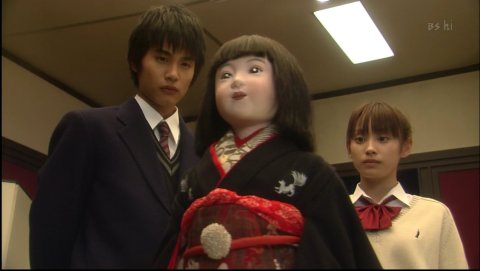

This feat is accomplished when the dolls’ eyes (intentionally designed by museum’s curator for this lethal purpose) collected enough static electricity to deliver a jolting shock to the character, interfering with his pacemaker and giving him a heart attack.
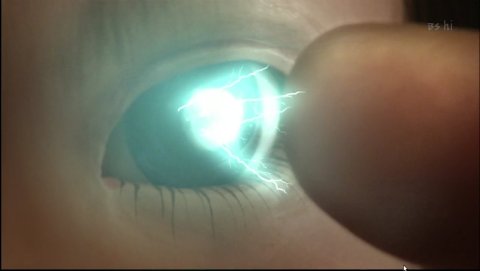
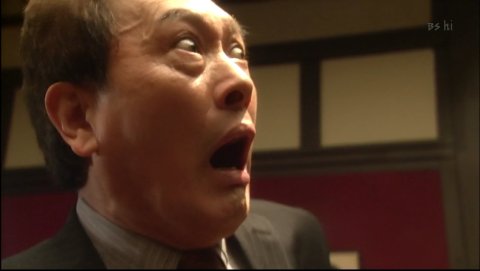
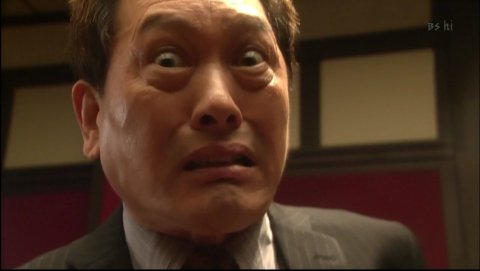

Oh, the agony … and the super-cheap special effects.
OK, I’m not going to comment on how practically feasible this whole gimmick is. The concept is flaky, the explanation is sloppy, and the acting seems a bit inconsistent with the explanation, but I’ll try to explain what I think is going on anyway—on a theoretical level.
As an explanation, MIT genius kid Touma Sou says the eyes are Leyden jars, which the show tries to spectacularize by displaying a faux-historical shot of a manuscript page depicting the eye as a Leyden jar, surrounded by informative-looking scientific text …
… until you realize what it actually says:
[…] Christ in Garmany has discoveed static to be
[…] to be accumulated with such apperatus the there
[…] qgo though it is assuumed that it was a wire
[…] straightens statice electricicity, and it was devised
[…] petel van Musschenbrooke peter van Masschenbroek
[…] the Nethelands in 1746. There is a name of
[…] Leyden jar” becaus of haping þeen inovented
[…] the Leydun university in the Netherlands.
[…] was widely used for experimental use of
[…]lectricity, and it was used to experiment
[…] B. Franklin‘s kite deep-frying.Insulator
Is a generic name of the
material that doesn’t pass electy
or heat easily. It is said to
conductor (electric condactor) that
conducts electricity easily the noncond
(..referrig…singing). Moreover, the
insulator shows the dielectric substance.The electric resistance of silver
Ag of the atomic symbol originates
in name “argentum” in Latin. Both of
the reflectivity of the electric condutivity
and the visible light ray are
the maximum in the metal
it was called “silvery white”
from the thing with
high reflectivity of
light in Japanese.Glass
No- quality solid where
glass transition phenomenon is
[…]
LOL at the “Christ in Garmany”? And I’m not really sure what Ben Franklin’s culinary prowess with respect to the deep frying of kites has to do with anything, so let’s move on.
Here’s the diagram again, with the three labeled surfaces explicitly marked A, B, and C. I’ve also labeled a screenshot of one of the eyes. Note that the diagram labels the “Insulator” and the “Glass” separately, apparently confusing the generic concept of an insulator with an actual insulating material. In this case, the two surfaces are the same thing, and I’ve labeled both of them C. A is the exterior conducting surface, apparently made of silver, and B is the interior conducting surface.
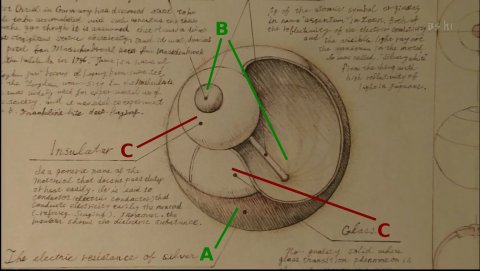
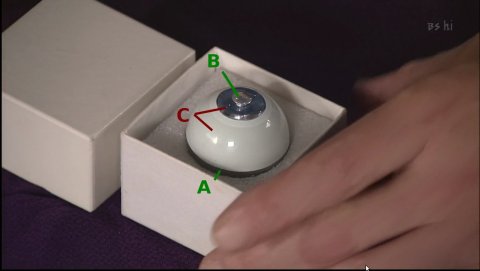
As the show explains, people walking with rubber-soled shoes across the wool carpet pick up negative charge due to the triboelectric effect. In appropriate conditions (cold, dry air), there’s no conducting path for this excess charge to dissipate from the body, so it remains. For someone with negative charge to experience an electric shock, the negatively-charged electrons on their body have to travel to a region of more positive charge. The electric potential between the two regions is greatest when the respective charges are furthest apart, so the best conditions for such a shock would arise when someone is touching a positively-charged surface.
My best guess for how this positive charge gets there is that it is induced by rubbing the (silk?) cleaning cloth against the porcelain surface of the doll’s face. Since silk is higher up on the triboelectric series than unglazed porcelain, a positive charge collects on the cloth. If the cloth then comes in contact with the pupil of the eyeball, its positive charge is transferred to the interior, as both pupil and interior comprise conducting surface B, and the close proximity of conducting surfaces B and A induces a negative charge on A. This works if A is properly grounded, which I’ll assume is the case.
The attraction between A and B allows B to collect a large amount of positive charge, enough to result in a big spark, though this is limited by the capacitance of the eyeball, which is probably not that high due to the apparently limited surface area of the two conducting sheets.
So when negatively charged unsavory character touches positively charged pupil, electrons discharge and enter the eyeball, causing said unsavory character to experience a huge shock, flail dramatically, topple to the ground, and expire. C’est la vie.
That’s my take on it. The show’s explanation, as far as I can tell, mentions negative charge on both bodies without discussing positive charge at all, which is necessary for the discharge to occur. In addition, Sou’s rubbing of the doll with a cloth clearly misses the pupil, which leaves the viewer wondering how that could have effectively transferred any positive charge into the eyeball at all.
I’m afraid that on a technical level, this episode leaves me much more disappointed than Episode 1, unless I totally missed what’s going on (and please enlighten me if that’s the case!). Oh, well. Let’s hope there’s more awesomeness to come….
EDIT: Did you think I was going to let you go without some physics equations? Of course not!
Let’s figure out how much energy is transferred when someone gets a shock from touching the doll’s eyeball. Since we’re not given all the information, let’s make educated guesses. Suppose the outer conducting shell has a radius of 2.5 cm, and it’s separated from the inner conducting shell by an insulating layer of 1 mm thickness. The diagram says it’s made of glass, so let’s give it a dielectric constant of 5. Furthermore, we’ll idealize the whole thing as a spherical capacitor, so as not to worry about those bothersome non-symmetric electric fields.
We can now compute the capacitance of the eyeball, replacing the glass with vacuum temporarily. If there is a charge of Q on the inner shell, the electric field at radius r outside between the two shells is
.
Integrating this over r between the two shells, we can compute the electric potential difference between them:
Since capacitance is charge divided by voltage, the capacitance is
The energy of a discharge depends on the charge Q transferred:
Assume a typical charge of 1 microcoulomb is transferred. Then, plugging in our assumed values (r1 = 2.4 cm, r2 = 2.5 cm, Q = 1e-6 J, ε = 5ε0), we have about 0.001498 joules, which is the amount of energy needed to move a one-kilogram block a height of 0.1527 millimeters.
I’ve been anticipating the new detective drama Q.E.D. starring Takahashi Ai and Nakamura Aoi since it looked like it would involve a lot of awesome math, and now that the first episode is out, we can see that there is indeed a lot of awesome math! And correct, non-trivial math to boot!

Hello! Project member + stereotypical MIT nerd = WIN!

Meet Touma Sou (Nakamura), stereotypical MIT math nerd! Who, having graduated from MIT at a very early age, is for some reason reattending high school … I’m sure this will be explained in future episodes …
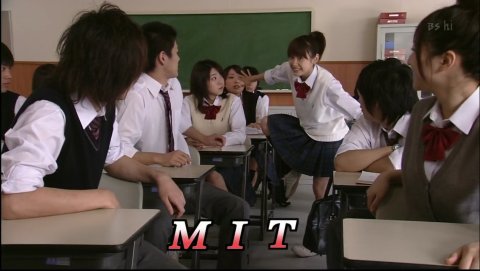
Mizuhara Kana (Takahashi) does an impression of MIT! D-:

Of course I am highly amused that “Massachusetts Institute of Technology” appears on the screen at the same time as Takahashi, who should definitely drop by for a visit sometime. I can show you around this place, Aichan, if you’re ever in the area.
Since “Q.E.D.” is traditionally written at the end of a math proof, this first episode of course features a math proof. As the show’s primary purpose is entertainment and not educational, it doesn’t focus on the details, but the details nevertheless are there and they’re intellectually stimulating, so I’ll cover that aspect here.
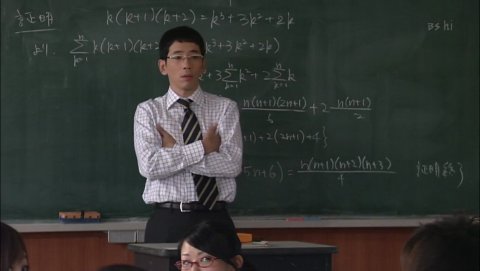
To begin with, the teacher presents the following proof in class:
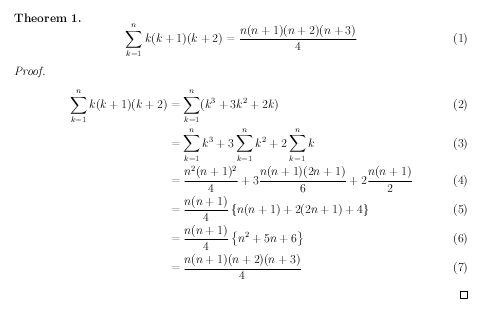
[If this is hard to read, it and the below proofs are available as a PDF.]
Let’s go through the details. The statement being proved is given in line (1). This is giving a closed-form expression for the sum of the product of three consecutive integers over a range. In line (2), the summed expression is expanded as a cubic polynomial: . This lets us use linearity of summation to split the sum into three parts (3). Then using summation identities, each of the three sums is expressed in closed form (4). In line (5), we factor out
, and in line (6), we group like terms of the remaining expression to produce a quadratic polynomial:
. This polynomial can be factored into
, leaving the desired expression (7).
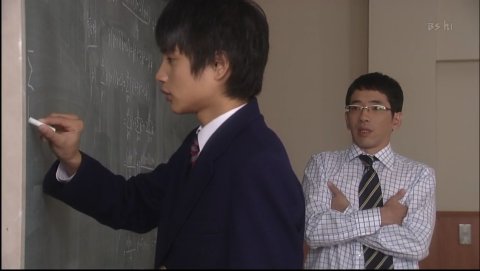
Of course, for Sou this is not nearly intellectually challenging enough. (The subtitles say that the teacher’s derivation is erroneous, but it’s correct as far as I can tell; if this is what Sou actually says, maybe the producers just wanted to avoid getting into details about the distinction between generalizing a theorem and offering a better proof of the same theorem.) Sou realizes that this fact can be generalized, establishing a more powerful theorem. Instead of having a product of just three consecutive integers , why not have arbitrarily many? Sou generalizes the theorem to apply to a product of
consecutive integers:
. And indeed, there is a closed-form expression for this as well:

Note that this reduces to the previous theorem if you substitute .
It’s a fun exercise to try to prove this theorem, which I encourage you to do if you’re interested. I did so, and I’ll present my own proof later on. As it turns out, Sou’s proof is simpler than mine, but due to camera angles and low resolution, it’s pretty hard to actually see what the proof is.

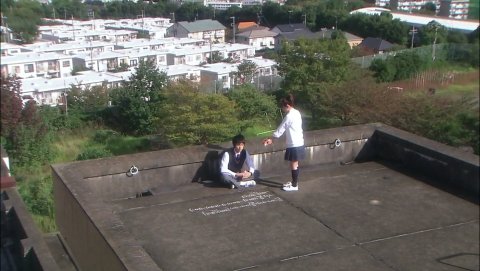
After much squinting and deducing, I finally figured it out:
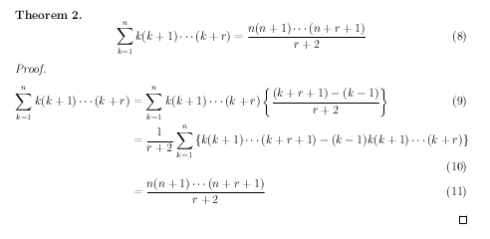
This is pretty short and makes some jumps that may not be intuitive, so I’ll go through the details:
In line (9), each term of the summation is multiplied by a ratio equal to 1, which does not change the value of the expression. You can easily do the math and see that the numerator is equal to . In line (10), the denominator of this ratio is pulled out of the summation, since it’s a constant factor, and the two terms in the numerator are multiplied with the product
, using the distributive law. Line (11) is probably the biggest jump in this proof; it’s using a telescoping sum, reducing a sum of terms by canceling out intermediate pairs. If you plug in
for
, you get
, and likewise, for
, you get
Notice that the
terms cancel when you add these together. If you keep doing this all the way to
, all the intermediate pairs cancel out, and you’re left with just two terms:
. The second term vanishes, so the overall expression is reduced to (11), which completes the proof.
The following is my own proof, which is a bit lengthier and uses binomial coefficients, along with Pascal’s second identity. Let’s first prove Pascal’s second identity, stated here as a lemma:
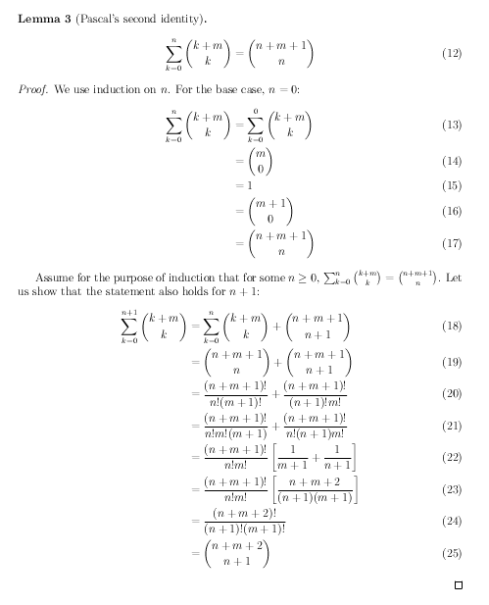
We use the principle of induction, which is showing that a statement holds for some base case (here ) and showing that if the statement holds for some
, then it has to hold for
as well. Putting these parts together, you prove that the statement holds for all integers greater than or equal to the base case.
Lines (13) through (17) prove the base case. This makes use of the definition of the binomial coefficient , which for
is equal to 1.
The inductive step is proved in lines (18) through (25). We assume the statement holds for and show that it also holds for
. In line (18), we split the sum of
terms into two parts. The first part is identical to the sum of
terms, which we can replace with
by the inductive assumption (19). In line (20), we replace the binomial coefficients with their equivalent factorial ratios, and in line (21), we factor
and
out of the two denominators, respectively. In lines (22) and (23), we factor out common factors of both terms, and add together the remaining fractions. Combining the two parts, we get (24), which can be written as (25), thus proving the lemma.
My alternate proof is as follows:
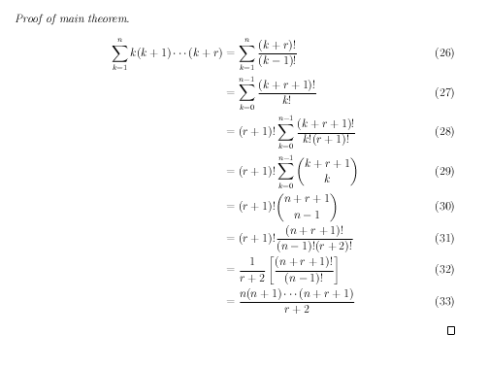
In line (26), we rewrite the product of consecutive integers as a ratio of factorials. We then reindex the summation (27) for convenience, so that
starts at 0. Next we multiply the entire expression by
and divide it by the same amount (28). Each term of the summation can be expressed in binomial form (29). Using Pascal’s second identity, we can rewrite the sum as (30). Turning this back into a ratio of factorials, we get (31). We can cancel out a
factor, leaving (32). Finally, expressing this ratio of factorials as a product of consecutive integers, we have (33), as desired.
(I’d stick a “Q.E.D.” at the end of that proof, but no one uses that anymore. The square box is sufficient.)
I’m definitely looking forward to more math and awesomeness in the upcoming episodes….
[The above proofs are available as a PDF.]
EDIT: Upon rewatching the episode, I discovered that Sou has excellent taste in reading material:
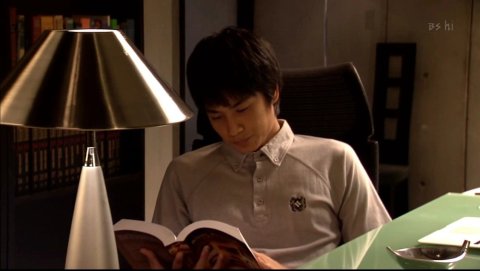
Douglas R. Hofstadter’s Gödel, Escher, Bach: an Eternal Golden Braid. I approve.
EDIT 2: Agggh!! What was I thinking? There’s a really easy inductive proof that I would have seen had I inducted on the right variable the first time. >_<
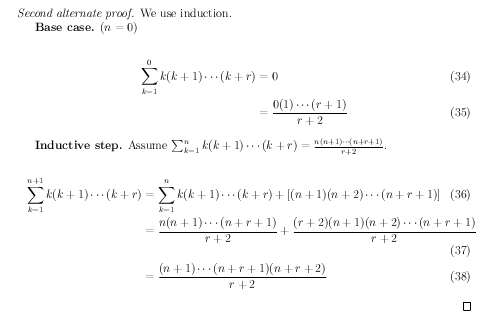
It’s, uh, self-explanatory.

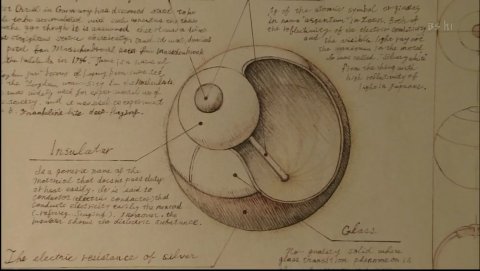

Recent Comments